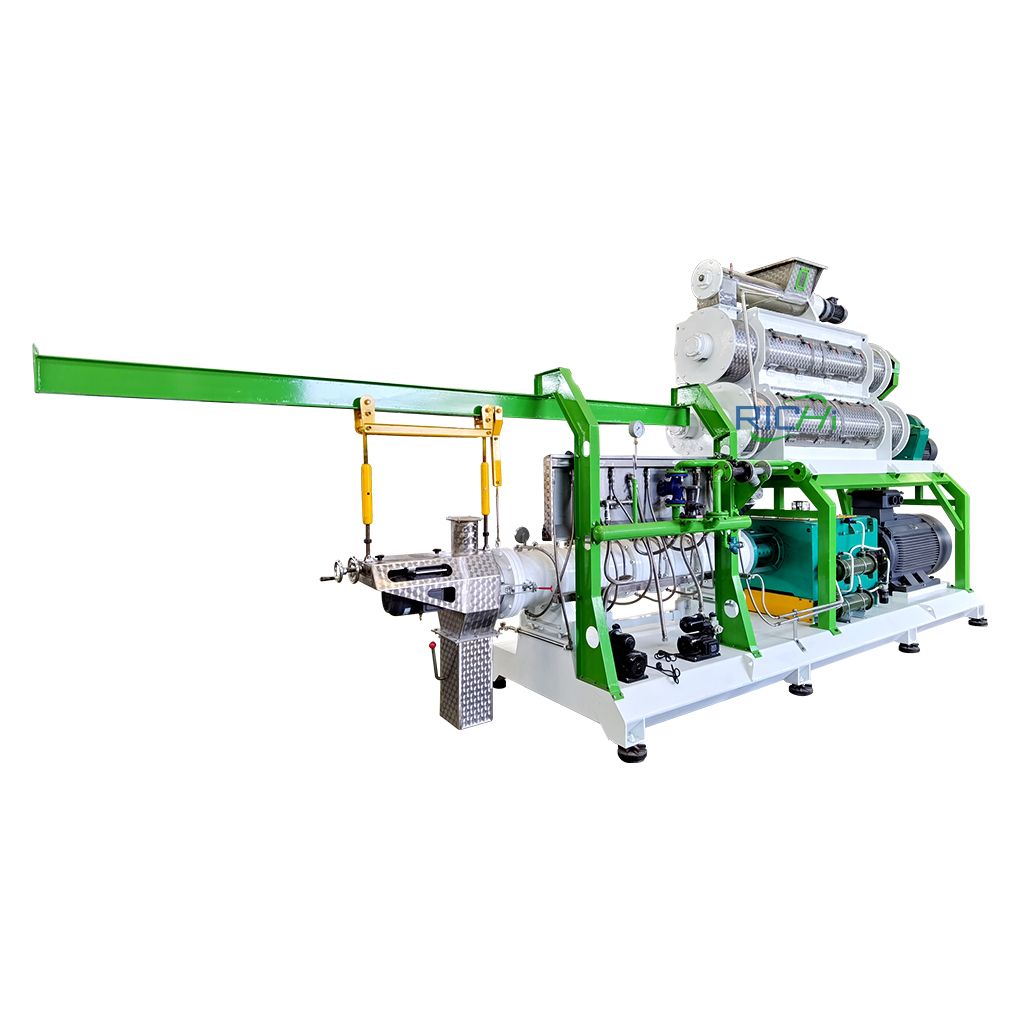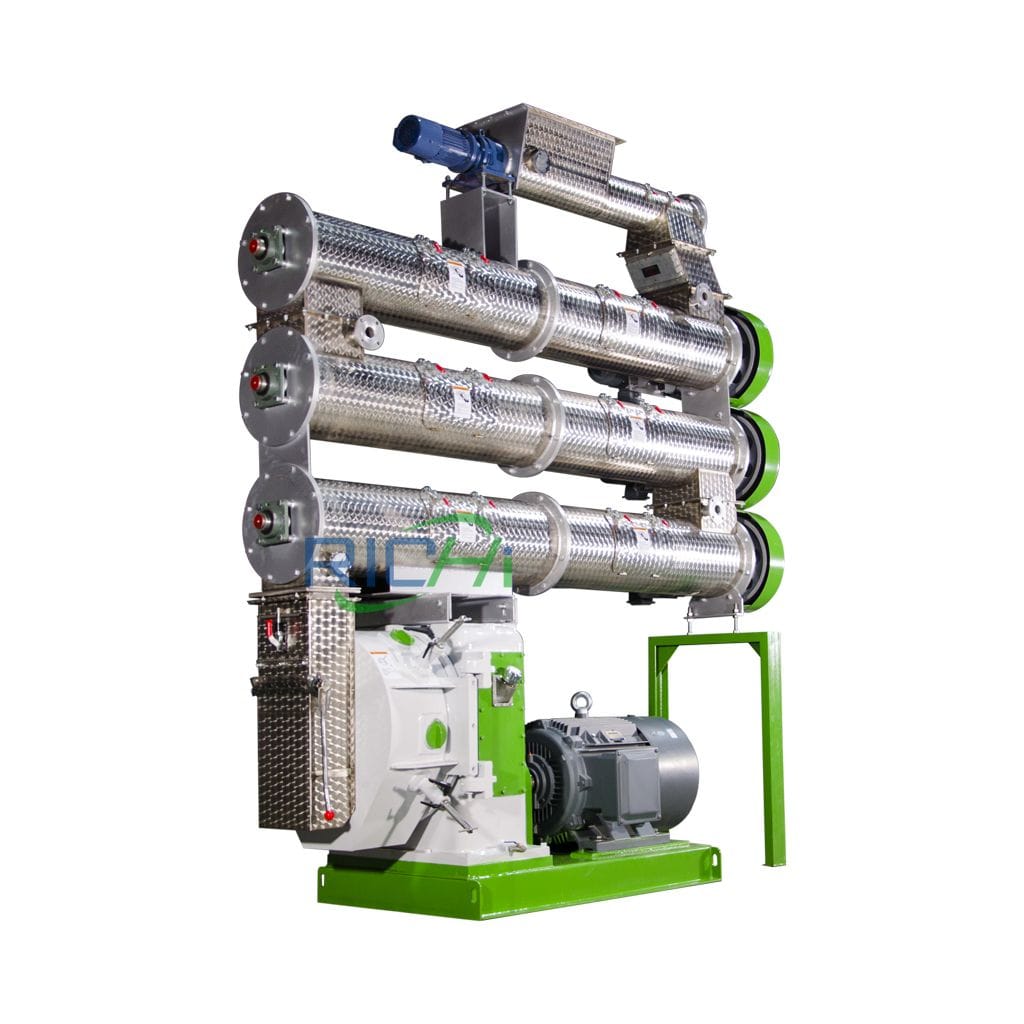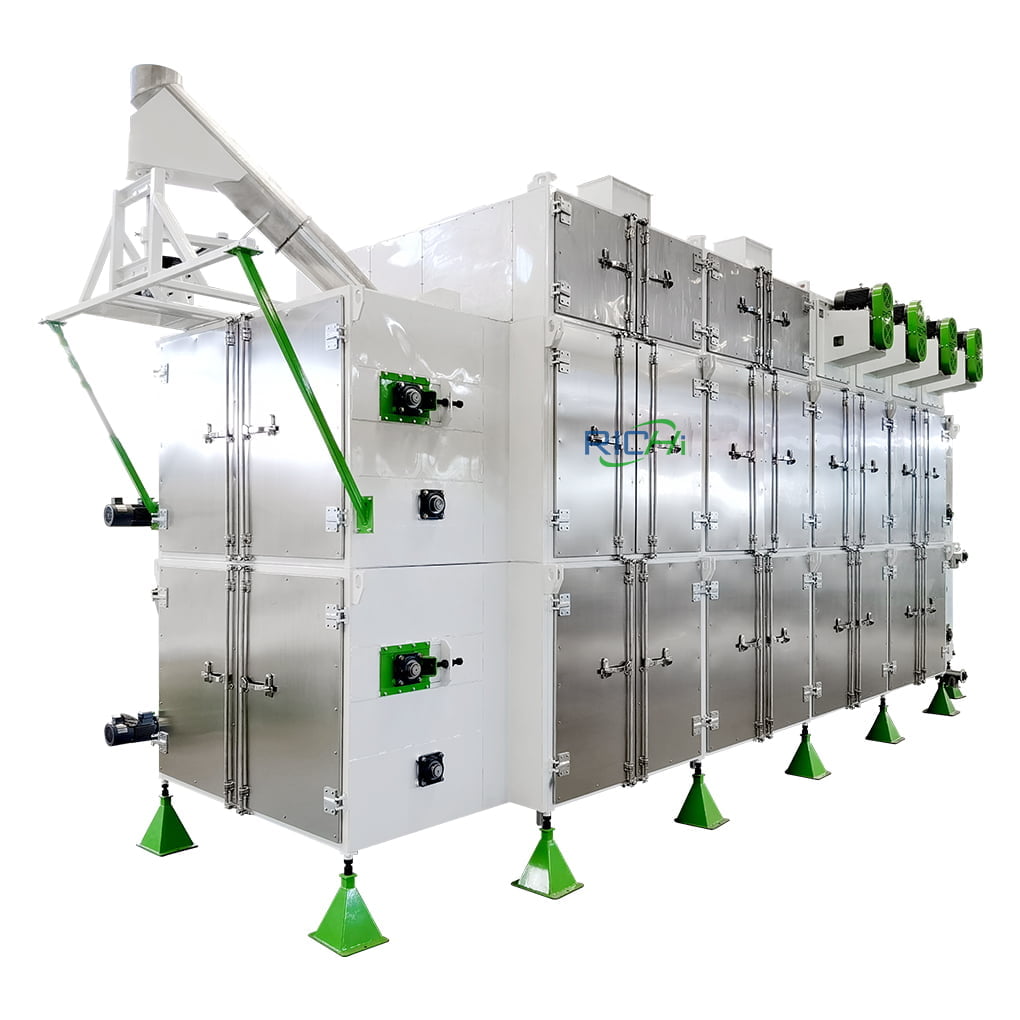
fish food factory
16-20T/H floating fish feed production
RICHI 16-20t/h fish food factory is suitable for all kinds of extruded feed processing. The configuration of the fish food processing line is carefully designed according to the on-site investigation situation or the actual requirements of customers, which fully reflects the rationality, effectiveness and applicability of the design, wide selection, reasonable matching, reliable quality, significant features of high cost performance.

16-20T/H fish food factory
According to different fish feed process requirements, RICHI can also provide overall design and construction plans, as well as turnkey fish food production projects in the field of aquatic feed processing, so as to meet the different process requirements of customers.
RICHI MACHINERY uses 3D design software for fish food engineering design. Each large and medium-sized fish food processing project is designed in advance with the factory area plan and the 3D diagram of the plant shape. The 3D diagram of the main workshop equipment and process layout is available for customers to choose. The design concept of saving time, saving money, safety, hygiene, reliability, high level of automation, and creating value for customers.
For customers, technical support is as important as product quality. Through our global sales team and technical support network, we always work closely with customers to solve technical problems in construction and keep construction smooth, develop new technologies that customers care about, and develop and produce fish food factory equipment that customers need.
Aquaculture is a sunrise industry, and it is certain that there will be bright prospects in the future. However, from the consumer side, there will be three major changes in demand for aquatic products, the first is safety, the second is nutrition, and the third is convenience.
In the future, the consumer market will pay great attention to these three elements of aquatic products, which will directly determine the choice of the market.
These three will be the needs to be considered by farmers, aquatic companies and even the entire aquatic industry in the future. More importantly, this is what we, Richi Machinery, are sure to satisfy our customers.
Process design of 16-20 t/h floating food factory for fish
As an important part of the feed industry, aquafeed has been paid more and more attention by manufacturers and aquaculture owners.
Due to the special feeding requirements of fish, shrimp and other aquatic products, the 16-20t/h fish food factory production technology and equipment are constantly updated and developed. Currently, floating fish feed pellet production are usually produced using two production processes:

- First batching, then crushing, then mixing, granulating, post-curing, cooling, grading, grading after leaving the warehouse, packaging and leaving the fish food factory;
- The ingredients are firstly crushed, then pulverized, mixed, puffed, dried, cooled, classified, and then classified out of the warehouse, and then packaged and shipped out.
Both of these two fish feed production processes can meet the fineness, the uniformity of mixed material particles, and the quality of granulated or extruded pellet required for the production of aquatic feed.
And can overcome the difficulty of single pulverization of high-protein materials and the over-fineness of raw materials after pulverization, and a series of problems in the production process of 16-20t/h fish food mill factory.
01 16-20T/H fish food plant cost
700,000-2,500,000 USD
02 Application
16-20T/H fish feed mill factory can process floating fish feed, pet feed, and can also be upgraded to a combined feed production line, and can process shrimp feed, special feed, livestock and poultry feed, premix and other products at the same time.

03 16-20T/H Fish Food Factory Can Be Customized
① The entire 16-20t/h fish food manufacturing project adopts a modular design, which can be customized according to the actual needs of customers, formula, plant structure, floor space and other requirements;
② 16-20T/H fish food factories with various forms (extruded pellet, powder, pelletized feed), various raw materials and formulas can be customized;
③ In addition to floating fish feed, if customers also want to process shrimp feed, livestock and poultry feed, pet feed, premix and other types, they can customize the complete production line plan according to the customer’s product plan;
④ If the customer wants to reserve the possibility of expanding the 16-20t/h fish food factory capacity in the future, we will customize the plan according to the customer’s plan.
⑤ In addition to the program customization of the process flow and equipment layout, we can customize the layout and program of the whole 16-20t/h fish food making project according to customer needs, including the layout of laboratories, central control rooms, office buildings, boiler rooms, restaurants, etc.
⑥ All 16-20t/h fish food processing equipment and electrical component laboratory equipment can be configured according to customer requirements, and motor and electrical component brands can also be changed according to customer needs.
⑦ In addition to new construction, it can also undertake technical renovation projects for floating fish feed production. There are several benefits to be gained from continuous upgrades, optimizations, and services on your equipment:
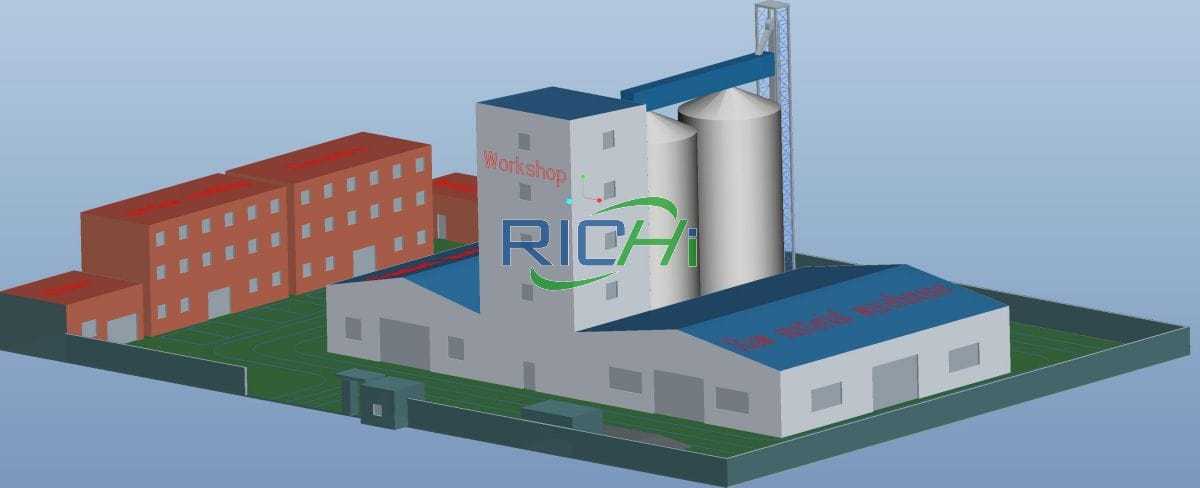
- Maximum fish feed production
- Process knowledge and experience
- Reliability and cost efficiency
- Reduced life cycle costs
- Short and effective shutdowns
- Improved energy efficiency
04 Composition of complete 16-20 t/h fish food factory
The following is only the composition of the standard 16-20t/h fish food making system, which can be designed according to the actual product type, process, formula and investment budget.
| Silo system |
| Raw materials revieving and crushing system |
| First-time crushing system |
| First-time batching and mixing system |
| Fine crushing system (Second-time crushing system ) |
| Second-time mixing system |
| Extruding and pelleting system |
| Drying system |
| Crumbling system |
| Liquid adding & coating system |
| Cooling system |
| Screening system |
| Packaging system |
| Stacking |
| MCC Control Center; Mimic Control Panel (CPP Computer System, Batching System (Computer controlled), Cables & Cable Bridge Tube) |
05 List of 16-20 t/h fish food production equipment
The following is only the core fish food processing machine list of the standard 16-20t/h fish food factory, and the equipment can be configured according to the actual product type, process, formula and investment budget.
| Pulse dust collector | Scraper conveyor |
| Bucket elevator | Pnenmatic three-way |
| Drum pre-cleaner | Permanent magnet drum |
| Storage bin | Hammer mill |
| Air-locked conveyor | Batching bins |
| Batching scale | Premix scale |
| High efficiency mixer | Buffer bin |
| Double cyclone | Ultrafine grinder |
| Screw conveyor | Square plansifter |
| Twin screw extruder | Coating machine |
| Fish feed dryer machine | Rotary screener |
| Screening system | Cooling machine |
| Automatic packing machine | Sewing machine |
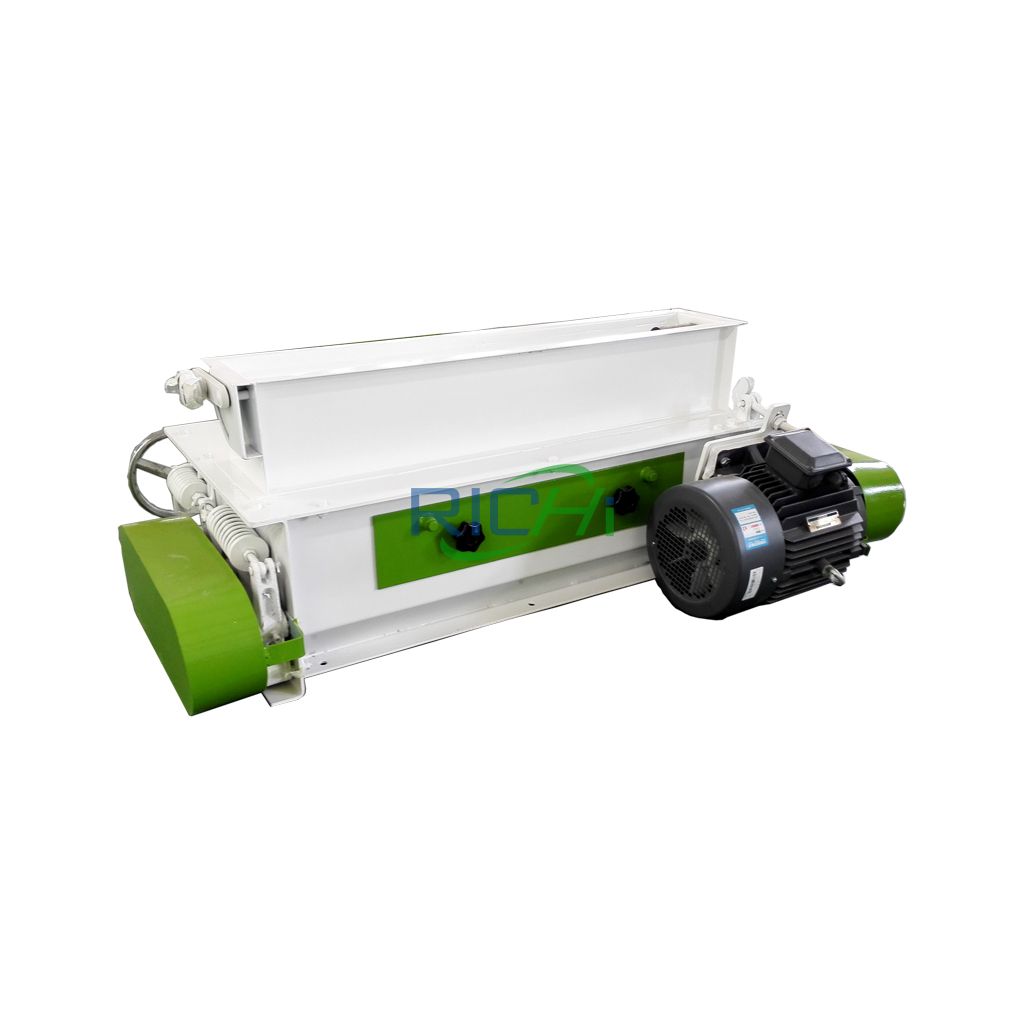
crumbler machine
Capacity:
3-8T/H
Roller:
2-3

Rotary Screener
Capacity:
1-2T/h
Main Power:
22KW

Spraying Machine
Capacity:
3-15T/H
Main Power:
22KW
06 Equipment layout principles of 16-20 t/h fish food factory
The first is to meet and ensure the smooth production process of the 16-20t/h fish food processing factory, and the second is to facilitate installation, maintenance and operation, and to ensure safety and economical rationality.
Generally, the construction of large and medium-sized fish food factories should adopt multi-storey buildings. The structure can be in the form of steel structure or reinforced concrete structure.
Ensure the smooth flow of the fish feed production process:
- ①The arrangement of the fish food making machine should be carried out in the order of the 16-20t/h fish food making factory process flow, and the height of the building should be used as much as possible to make the material flow freely, reduce the number of lifting times, and save the land occupation and construction area;
- ② The same fish food making machine should be arranged centrally for easy management;
- ③ The magnetic separation equipment in the cleaning section is placed after the primary cleaning screen, and the magnetic separation device is equipped in front of key equipment such as pulverizers, granulators and extruders;
- ④The arrangement of the batching bins is reasonable, which is conducive to the arrangement of the feeders. The layout of the batching bins can be rectangular or circular, and the batching bins should be equipped with exhaust facilities; The distance should be no more than 0.5m to reduce the air drop and ensure the batching accuracy;
- ⑤ For fish food making machine with large vibration and noise, such as crushers, it can be arranged on the first floor or basement, and a soundproof room should be installed on the first floor or other levels;
- ⑥ Equipment with large vibration should not be arranged around the batching scale, and the central control room should have sound insulation and air-conditioning facilities to ensure the batching accuracy;
- ⑦The fish feed mixer should be arranged below the batching scale, and the volume of the buffer bucket under the mixer should be configured according to the type of mixer, but at least one batch of materials can be stored; the conveying distance between the mixer and the finished product warehouse should not be too long;
- ⑧ The return pipe of the fish feed pellet machine and the floating fish feed extruder machine must be connected to the inlet head of the feeder to ensure the smooth flow of the 16-20t/h fish food productioon factory process. Air conditioners, dryers and grading screens should be directly arranged in the next channel, so that all kinds of materials can easily enter their respective processes;
- ⑨ When the height of the finished product warehouse is greater than 5m. The warehouse should be fortified with a classification device, and the height of the finished pellet warehouse should not exceed 5m to reduce pellet breakage;
- ⑩The equipment layout of 16-20t/h fish food factory should ensure the angle of the chute. Generally, the material should not be less than 50~60°. At the same time, the material flow angle of the equipment discharge hopper and hopper should also be ensured, and the general angle should not be less than 45~50° to prevent the occurrence of grading and self-flow. unsmooth phenomenon;
- ⑪The combination of the dust removal air network should be based on the principle of homogeneous integration. The dust removal air network and the cooling air network should be reasonably arranged, and the length and elbow of the air duct should be minimized to reduce resistance and energy consumption. For fans with high noise, measures such as sound insulation and noise reduction should be taken. Install a butterfly valve at the inlet of the fan. The drop of ash collecting pipes of dust removal equipment and impurity removal equipment should be low, and dust circulation should be avoided;
- ⑫For the conveying equipment installed in the open field, the elevation of the floor should be 0.15m higher than the elevation of the 16-20t/h fish food project site.

Easy to install and maintain
- ①The equipment should be arranged neatly, and leave enough safe walkways and operation and maintenance distances. Generally, the width of the walkway is 1~1.2m, the width of the main walkway is 1.2~1.5m, the horizontal walkway between the equipment is 0.6~0.8m, and the distance between the non-operation surface of the equipment and the wall is 0.35~0.5m. When arranging equipment such as cylinder cleaning screen, vibrating grading screen, hammer mill feed grinder, etc., special attention should be paid to leaving enough operating space for replacement parts;
- ②The maintenance hook should be set above the large equipment, and the load and height of the hook should be determined according to the maximum load and minimum lifting requirements of the equipment;
- ③ Hanging holes shall be provided on each floor of the multi-storey fish food factory building, and the upper and lower floors shall be aligned. The size of the hole and the load of the hook on the top of the hole are determined according to the largest part of the fish food equipment. A cover plate or a railing shall be laid on the hole;
- ④Flanges on equipment or pipelines shall not be arranged in the holes passing through the floor or wall, so as not to affect the maintenance, and the reserved holes should leave enough space for operation;
- ⑤The easy-to-wear chute, tee, distribution plate and hopper need to be equipped with wear-resistant plates, and at the same time consider the inspection door and set up the inspection platform;
- ⑥Cylinder warehouse and batching warehouse, transition bucket and finished product warehouse of large feed factory, a ladder should be set up in the warehouse;
- ⑦Every motor should be set with a base or an anchor rail, which is convenient for maintenance.

Easy to operate and ensure safety
- ① The operating points of the fish food factory equipment, such as the handwheel of the gate, the wrench of the flap, various buttons and the refueling point, etc., should be placed within the range of human hands and easy to operate. If there is difficulty, adjust the installation height, add an operating platform or step. For the gate that is too high, the hand wheel can be replaced by the hand zipper chain wheel;
- ② Pay attention to the convenience of the passage of the workshop, and the passage of the stairs should not be too steep or narrow; the stairs should be placed indoors as much as possible; the climbing ladder should be used as little as possible;
- ③ Safety railings should be set up on the edges of stairs, walkways, roofs, warehouse roofs and operating platforms;
- ④ All rotating equipment components, such as couplings, pulleys and transmission belts, sprockets and chain drives, must be equipped with protective covers;
- ⑤ Any pipes, air ducts, transition buckets, etc. with a certain weight should be provided with brackets or hangers for support and fixation, and their weight cannot be directly pressed on the relevant equipment;
- ⑥ The distance between the side of the foundation bolt hole and the foundation should generally not be less than 0.1~0.15m. When the diameter of the bolt is small and the length is short, take the lower limit, otherwise, take the upper limit to ensure the installation quality of the anchor bolts and facilitate civil construction.
The quality of 16-20t/h fish food factory engineering is firstly designed, followed by manufacturing and installation. High-quality engineering design is a necessary condition for obtaining high-quality projects, but it must be guaranteed by high-quality engineering manufacturing and installation. In order to obtain a high-quality 16-20t/h fish food project, we must do a good job in every detail of the manufacture and installation of the fish feed factory project.
Cases of 16-20 t/h fish food factory
Richi Machinery continuously develops and improves technologies and processes, and adopts the production process of floating fish feed plant solutions, which can produce animal feed with a larger ratio of feed to meat.
While ensuring the economic interests of fish feed manufacturers, they pay more attention to the health of animals, so as to ensure the green safety of downstream products in the food chain.
For a long time, RICHI has market-leading production technology and integrates it into products and floating fish feed plant engineering.
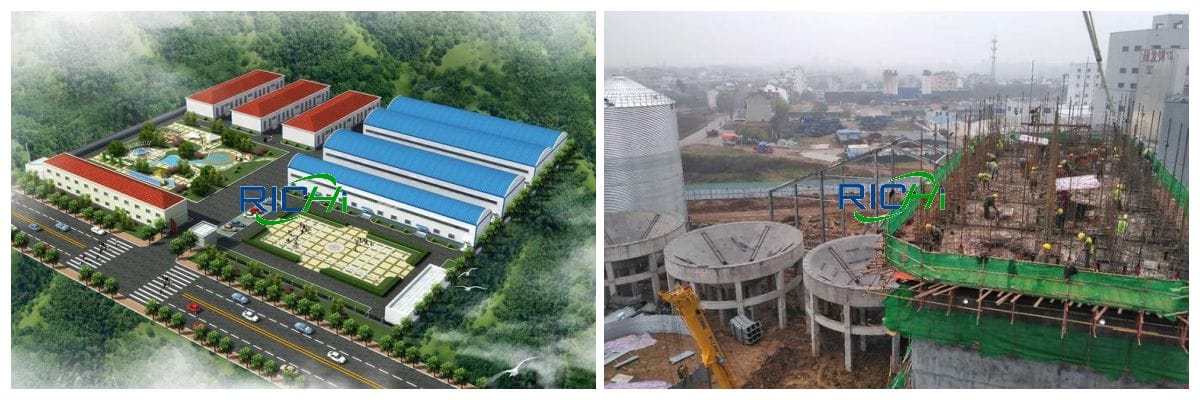
4T/H
16 t/h floating fish feed plant

5T/H
20 t/h floating fish feed plant
20 t/h fish food factory Project Report
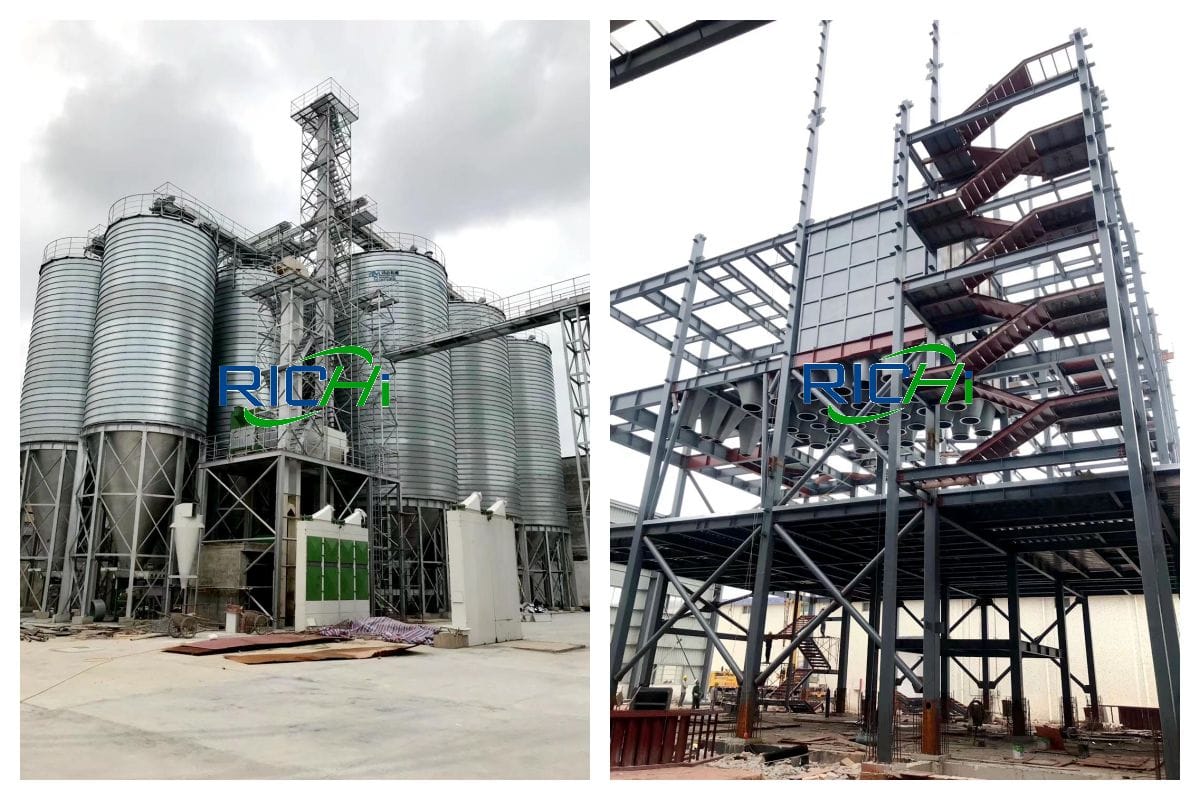
In 2019, in order to meet the market demand, the customer invested an additional US$1 million to expand the existing feed factory area. After the expansion, 20t/h (50,000 tons/year) of special aquatic extruded feed was added, and the original 30,000 tons/year livestock and poultry. The feed production line remains unchanged.
The customer’s original feed factory in this project was built in April 2013, and in June 2013, the investment was about 350,000 US dollars to build the “annual output of 30,000 tons of feed production line project”, which was undertaken by us at that time. The main construction contents of the project are: 1 production workshop (5 floors in the main production area), 1 finished product warehouse, 1 raw material warehouse, as well as packaging room, office space and corresponding environmental protection facilities.
The project uses corn, soybean meal, wheat bran, wheat, rapeseed, cottonseed and other raw materials as raw materials, through the mixing and crushing of ingredients, the annual production of livestock and poultry feed, and the annual production of pig, chicken, duck and other compound feed 30,000 tons.
This expansion 20t/h fish food factory project is mainly engaged in the production of special aquatic extruded feed, with an annual output of 50,000 tons of special aquatic extruded feed.
This expansion 20t/h fish food processing plant project does not add new construction land, but only expands the special aquatic extruded feed production workshop in the original factory area.
And expands the raw material workshop, product workshop, packaging workshop, office space, hazardous waste temporary storage room, solid waste temporary storage room, etc. All rely on the original project, not new. The maximum storage capacity of the finished product warehouse is 500t.

- Factory area: The expansion 20t/h fish food line project covers an area of 2400m2 and a building area of 2400m2.
- Power consumption: 500,000 KWh/a
- Water consumption: 758.45m3/a
- Working system: There were 23 employees before the expansion, and 7 new employees were added this time. 300 working days throughout the year, 1 shift per day, 8 hours per shift.
Main raw materials of 20 t/h fish food factory
| Name | Consumption (t/a) | Name | Consumption (t/a) |
|---|---|---|---|
| Corn | 15000 | Wheat Bran | 2800 |
| Wheat | 1000 | Rapeseed meal, cotton meal | 2500 |
| Soybean meal | 20000 | Rice bran meal | 1400 |
| Calcium Carbonate Powder | 500 | Fish meal | 5000 |
| Grease | 1000 | Salt | 60 |
| Vitamin Additives | 35 | Amino Acid Additives | 140 |
| Propionic acid type mildew inhibitor | 60 | Enzymes | 27.8 |

Main fish food making machine of 20 t/h fish food factory
| Equipment Name | Model | QTY |
|---|---|---|
| Scraper conveyor | TDJSS10 | 2 |
| Double Shaft High Efficiency Mixer | SLHY2-2 | 1 |
| Cooler | SKLN24*24 | 1 |
| Pulse Dust Collector | TBLMFa32 | 6 |
| Bucket elevator | TDTG36/23 | 2 |
| Preliminary Screening | ZCCQ100 | 1 |
| Water Drop Hammer Mill | SFSP138*50C | 1 |
| Auto Packer | DCS | 1 |
| Screw Conveyor | LXG250 | 3 |
| Superfine Pulverizer | TDCWF | 1 |
| Automatic batching system | TSC-1000 (including batching bin) | 2 |
| Extruder | RCPH185*2 | 1 |
| Dryer | WDWS220/5-4 | 1 |
| Rotary Classifier | SFJH140-2C | 1 |
| Counterflow Cooling Tower | 25*25 | 1 |
Production Process of 20 t/h fish food factory
This 20t/h fish food project is a reconstruction and expansion project. The buildings of the factory area are all based on the original factory buildings, and there is no need to excavate and build new buildings. Therefore, the construction period is relatively simple, and only the factory building renovation and equipment installation required for the fish extruded food factory are required.
The 20t/h fish food production process of extruded aquatic feed adopts the production process of first grinding and then batching, intermittent mixing, (super) micro-grinding, second batching, puffing, drying, oil injection, cooling (air cooling), screening into the finished product warehouse and complete packaging.
01 Feeding and cleaning section:
Since the raw materials purchased by the 20t/h fish food factory contain a certain amount of impurities, the feeding port is equipped with a grid screen which can be used as the first impurity removal equipment to remove impurities such as sack lines. Each feeding port is separately equipped with a square pulse dust collector; the powder and meal are manually unpacked in the aquatic feed production workshop and put into the feeding port.
After cleaning and iron removal by scraper and elevator, the meal enters the waiting port. The crushing bin, the powder and auxiliary materials enter the batching bin.
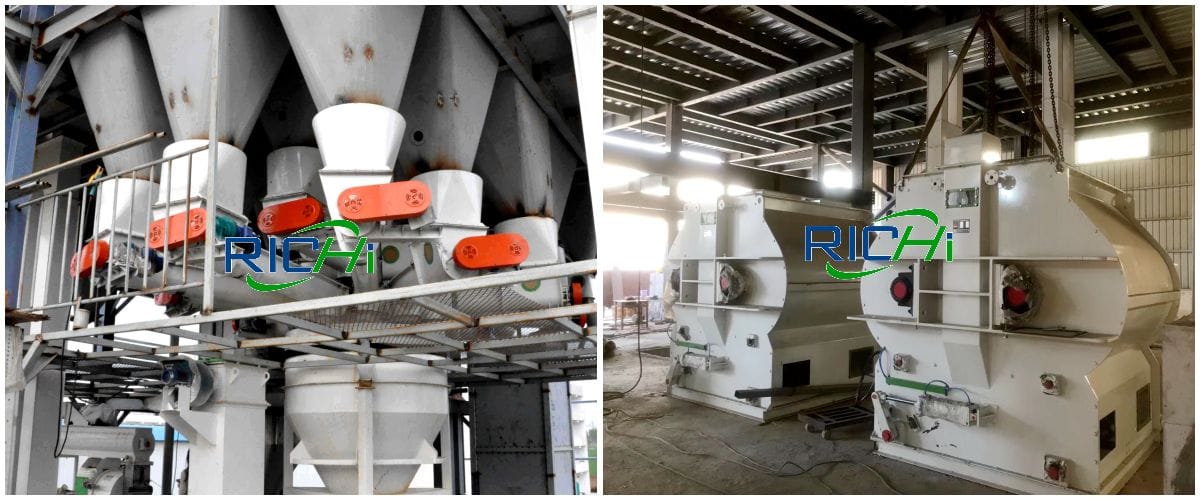
02 The first crushing section:
Due to the large particle size of raw materials such as corn and soybean meal, they need to be crushed to meet production requirements, so that they can be turned into powdery materials.
03 The first batching mixing section:
The batching process used in this 20t/h fish food factory project is batching with multiple bins and scales, which is a kind of automatic batching. The crushed raw and auxiliary materials are sent to different batching bins by the distributor.

04 The second ultrafine pulverization section:
In order to increase the taste of the feed and make the feed more suitable for fish consumption. After the various raw materials are mixed, they will enter a closed ultrafine pulverizer for the second pulverization.

05 The second batching and mixing section:
According to the requirements of the formula, various raw materials participating in the ingredients are metered into the mixer in turn, and various core materials are added in the mixing process. The mixing cycle is 6 min.
06 Puffing and tempering——20t/h fish food factory:
The raw materials after the second pulverization enter the single-cylinder conditioner, and the materials are expanded and tempered by high temperature and high pressure (about 120 °C, 2 atmospheres).
07 Drying and oil spraying:
Due to the introduction of high temperature and high humidity steam in the process of puffing and tempering, and a large amount of heat generated by the extrusion of materials, the extruded aquatic feed has a high moisture content when it comes out of the conditioning machine, such as direct storage. Therefore, the extruded feed is dried by steam heat exchange, and oil is sprayed into the feed at the same time to increase the edible taste of the feed.

08 Ventilation and cooling process:
The temperature of the material coming out of the fish feed dryer machine is as high as 70°C -85°C. Under this condition, the pellet feed is easily deformed and broken. This process adopts the form of countercurrent ventilation and cooling to reduce the feed temperature to below 8°C higher than the room temperature.
09 Screening, packaging and storage process:
The cooled feed, after screening, enters the finished product warehouse with qualified particle size, and is packaged and stored in the warehouse through an automatic packaging machine.

Note:
- The 20t/h fish food factory project will generate dust during the feeding, crushing, mixing, screening and packaging processes. Therefore, the process considers installing fans and pulse dust collectors at various dust generating points to recover useful materials and reduce dust pollution in the workshop. .
- The steam required for puffing, tempering, drying and other processes in this 20t/h fish food production project comes from centralized gas supply, and there is no boiler gas supply in this project.
Layout of 20 t/h fish food factory
The gate of the 20t/h fish food line project is located near the village road on the west side. The 20t/h fish food plant area is mainly divided into living area and production area.
The main production workshop of the original project livestock and poultry feed production line is located in the center of the plant area, the finished product warehouse is located in the west side of the center of the plant area, and the raw material warehouse of the 20t/h fish food mill factory area is located in the east.
The packaging room is located in the southwest corner, the 20t/ht expansion fish food project is located in the east of the raw material warehouse, and the office space in the living area is located in the northwest corner.

From a policy perspective, the world now pays great attention to ecological and environmental issues, especially carbon emissions in economic development.
Livestock and poultry farming also cause a lot of carbon emissions, and aquaculture has an incomparable advantage in this regard. Producing aquatic products that provide the same quality of protein emits far less carbon than raising livestock and poultry.
The two strategies to face the new changing situation are the great development of the industrial chain and the great upgrade of feed enterprises. Select high-end varieties in the industry, develop the industrial chain for intensive processing; and then improve international competitiveness through brand building.
Feed products need to be responsible for nutrition and environmental protection. Pellet feeds are upgraded to extruded feeds, and low-grade feeds are converted to high-grade feeds; functional health-care materials are used to ensure food safety, and attention is paid to animal protection and water adjustment.
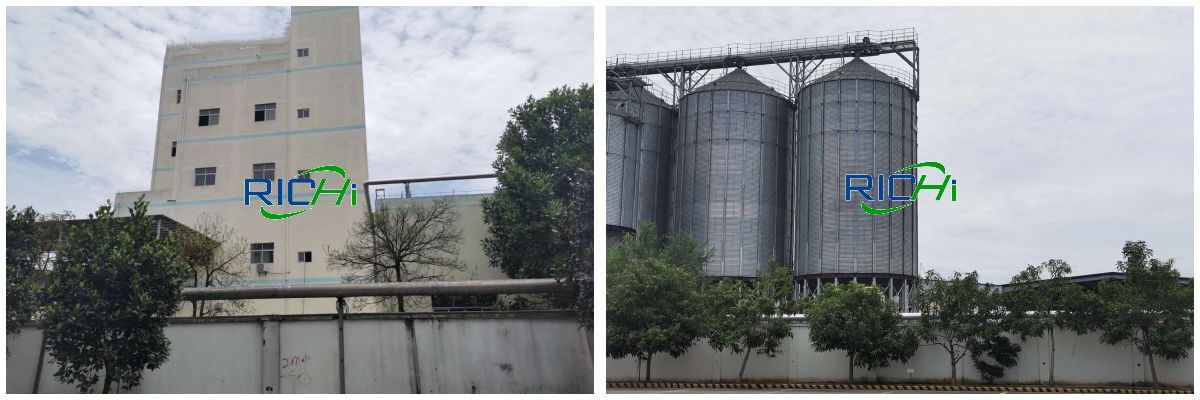
The RICHI MACHINERY engineer team’s “return to product technology and think about everything” is not a simple slogan, but a systematic development concept.
Deeply understand fish food processing technology and breeding benefits (operation), explore the real pain points and benefit improvement points of mainstream feed processing models, formulate cost-effective products and fish food system technical solutions, and effectively serve customers through solutions, so that users can obtain higher than the market average.
At the same time, it realizes the conversion and promotion of product sales, continues to shape the brand image of RICHI “fish food production unit supplier”, and builds the competitive advantage of RICHI fish feed equipment beyond price.
Richi Machinery has a history of nearly 30 years. It undertakes the process and civil engineering design tasks of various complete sets of fish food system projects. It has designed more than 2,000 projects of various types. The engineering projects designed include: aquatic feed engineering and special aquatic feed engineering, pet feed Engineering, livestock and poultry feed engineering, pasture pelleting engineering, straw feed engineering, premix engineering, concentrated feed engineering, hop pellet production line, wood pellet production line, biomass pellet production line engineering, etc.


Richi Machinery is always based on market trends and customer needs, constantly seeking changes and improving, timely innovation, and relying on standard fish food production solutions, flexible and reasonable configuration of fish feed factory equipment, to achieve stable performance and mature customized design.
If you have any needs or questions about the construction of floating fish food factory, please leave a message and we will reply to you as soon as possible after receiving it! You can also contact us directly via WhatsApp (+86 138 3838 9622)!
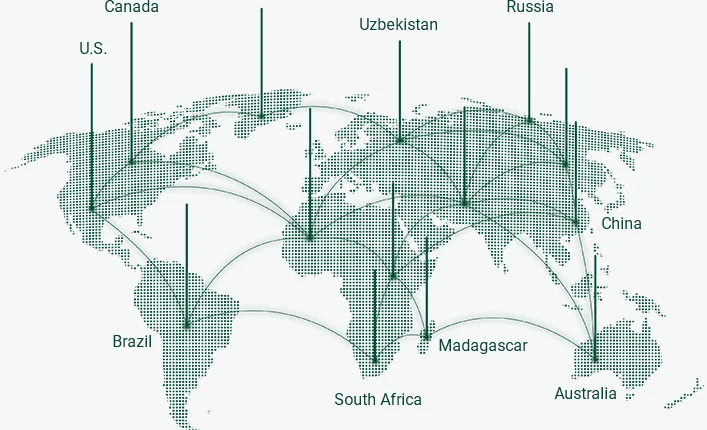
2,000+ /PROJECTS
In the past 30 years, as floating fish feed plant factory manufacturer, we have accumulated rich experience. We has exported floating fish feed plant equipment for sale the world, and has reached cooperative relations with more than 2,000 customers in more than 130 countries and regions, providing them with complete solutions and services covering the entire product life cycle.
130+ /COUNTRIES
Customer experience is the touchstone. Richi Machinery has benefited a lot from winning the market with connotative products and high-quality services. Richi Machinery specialize in floating fish food equipment for sale, our floating fish food factory machines are carefully designed for customers according to the actual feed production requirements.



